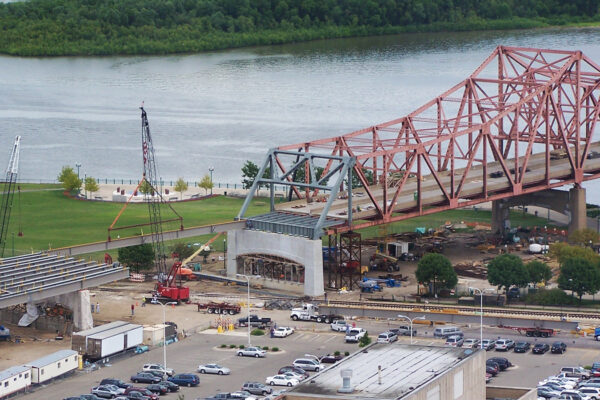E03856 SR 3028-SWB – JFK Blvd over SEPTA

Benesch designed the rehabilitation of the 400-foot-long interconnected tunnel structure supporting JFK Boulevard over SEPTA’s electrified double track airport lines in order to extend the useful life of the structure by at least 30 years. The critical repairs to the bridge over Walnut Street Tunnel restored safe travel for both vehicle traffic above and passenger train traffic below while improving the overall appearance of the boulevard.
The project included the use of Accelerated Bridge Construction (ABC) techniques for bridge joint replacement, concrete deck repairs and critical steel repairs to remove the 15-ton load posting on the bridge. Constructed in 1955, a series of steel columns supporting the tunnel ceiling were experiencing advanced corrosion and section loss. While the existing columns at the joints were replaced due to severe deterioration, it was not feasible to replace every column. To accommodate the short construction duration, ultra-high performance concrete (UHPC) encasement was used for the first time in North America to strengthen and protect the steel columns. UHPC is self-consolidating and has a low permeability, therefore it was the preferred option for this high-moisture tunnel environment.
This project required balancing the needs of various stakeholders with respect to traffic, schedule and budget. Through coordination with SEPTA, a three-week rail outage was planned with substitute busing from the airport to JFK Boulevard made the project possible. Prior to construction, a site visit in the tunnel revealed that one of the columns supporting the tunnel had 100 percent section loss to the web. This required an emergency shut down of a portion of JFK Boulevard. Benesch was asked by SEPTA and PennDOT to design an emergency repair to the column in a day. The repair was installed in a matter of days during a nighttime outage of the tunnel allowing the tunnel to remain open until permanent repairs were in place.
The project’s schedule coincided with the statewide COVID-19 shutdown but was able to proceed under emergency authorization by the Governor. The Airport Line outage was extended to seven weeks due to low SEPTA ridership during the statewide shutdown. Due to the short shutdown of the tunnel, Benesch was on call 24/7 addressing SEPTA concerns and contractor questions as they came up.
During design it was noted that steel procurement and fabrication would be a delay to the schedule if completed after a contractor was awarded. A separate emergency SEPTA contract was bid prior to selection of the contractor allowing the steel to be procured. This helped keep the project on schedule. An additional problem that arose during construction involved unexpected damage to some of the columns and beams to remain by a subcontractor. Benesch worked with SEPTA and PennDOT to develop a solution to repair those members while maintaining the project schedule.
The rehabilitation was integral to the $6.5B Schuylkill Yards urban revitalization initiative and one of four major projects Benesch is completing as part of this initiative.










